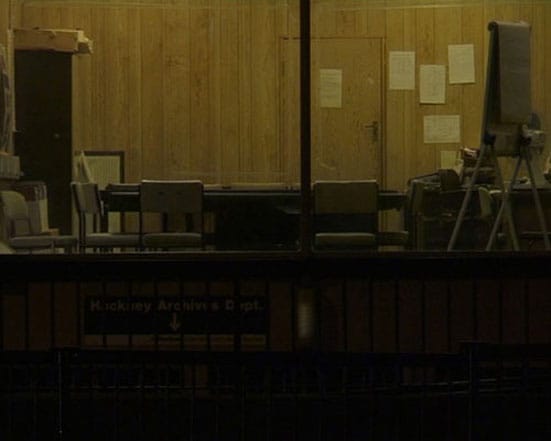30th November 2006 — 14th January 2007
A
Public Lecture and Exhumation is a complex artwork. In a 25 minute
video it presents a forgotten bequest to the Borough Council of
Stoke Newington and documents aspects of its enactment by the artist.
The will and bequest (1927), that of a certain Alexander Chalmers,
leaves money for seemingly innocuous cultural enrichment such as
the purchase of paintings or bronzes, annual dinners, and essay
writing competitions for local schoolboys. In executing the bequest
Price has inserted its instructions into the district's new cultural
regime, inviting art-scene familiars to involve themselves in the
services it offers. There are, for example, photos by Neil Cummins
and Marysia Lewandowska, schoolboy essays by Dave Beech and Nathan
Coley while Iain Sinclair is listed as the guest of honour at the
dinner party.
Little of this detail though can be gleaned from
watching the video. Indeed the video itself has deliberately been
constructed so as to confuse rather than make clear. Vital narrative
information is withheld. At the beginning there are stills of the
town hall in Stoke Newington but no accompanying history that they
might be supposed to support. When the context does make the subject
matter clear, for example that we are being shown a vault containing
artworks, the images are too dark, too quick or too out-of-focus
to get a sense of what they are of. Even when we have reason to
believe we have made sense of what we have seen, a Victorian effigy,
a wrapped painting, the end credits to contemporary artists cause
us to doubt our understanding. So despite its promise of slick,
corporate clarity (there is even a Microsoft Power Point style "Welcome"),
and all the trappings of good communication (subtitles, cinema-style
surround sound, photos, video), little about the archive, its benefactor
or its purpose is revealed. Instead, in the video at least, the
past fuses with the present and the historical precedent becomes
indistinguishable from its enactment.
If Chalmers's will has been
acted upon it is because it is deemed relevant now. In his Theses
on the Philosophy of History Benjamin observes: 'Every image of
the past that is not recognised by the present as one of its own
concerns threatens to disappear irretrievably.' (1) Benjamin advocates
a now familiar historicism in which the past is revealed as present
and contemporary pageant provides a crucial reminder of lessons
to be learned. Thus, images of Vietnam have seen something of a
revival during the recent stages of the Iraq war and there is an
art-world appetite for the restaging or remaking of avant-garde
artworks in the face of increasing institutionalisation. But it
is unlikely that Price is serious about reviving oil painting or
schoolboy competitions. Indeed many of the commissioned artworks
wisely stay clear of carrying out the instructions too literally
and offer their services as a critique of Chalmers's misguided
ambitions. The value systems, arbitrary choices and distasteful
hierarchies of Chalmers and the collaborating institution come
under scrutiny so that the contemporary additions are easily distinguishable
from earlier ones. But the 'Lecture and Exhumation' goes beyond
this in its consideration of redundancy. For where the past is
indistinguishable from the present and the past is in ruins, it
cannot have escaped the notice of the artists involved in this
collaboration their humorous condemnations of Chalmers's cultural
aspirations must also be made of the present.
(1) Benjamin, Walter "Theses
on the Philosophy of History" in Illuminations, ed. Hannah
Arendt. Pimlico.1999.
NF
Studio Voltaire
1a Nelson's Row
London SW4 7JR
http://www.studiovoltaire.org/
Open
Thursday-Sunday, 1pm-6pm

Elisabeth
Price
A Public Lecture & Exhumation
Video Still
2006
Courtesy
of the Artist